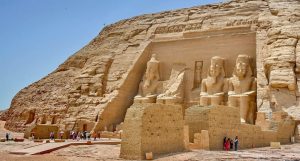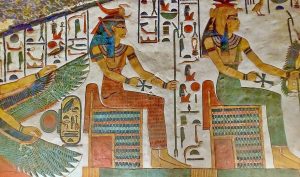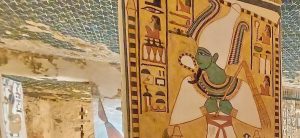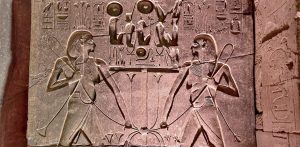The History of the Hyksos and the Invasion of Ancient Egypt: From the 13th Dynasty onward, Egypt underwent a period of societal instability and disintegration known as the Pharaonic Period. A large number of Asian immigrants took advantage of the circumstances to gradually infiltrate the land of the Nile, where they were able to advance to military posts or work in the crafts and commerce industries. This fact laid the groundwork for the violent conquest of the nation by these Asians, known as the Hyksos, who would reign for two centuries and establish a dynasty in the process. Hyksos were a Semitic people that settled in the Nile Delta region and invaded Egypt in the 18th century BC, or between 1700 and 1900 BC, during a period of internal turmoil that allowed them to seize control of the country’s government, where they established a dynasty of their own.
A group of Asian people

Multiple hypotheses have been put up to explain how and why they came to be. The most widely accepted one is based on their origins in the East, where they were diverse groups hailing from the region of Palestine and the eastern areas along the Nile. It is possible that they had a Semitic component, and everything appears to imply that they had been in contact with Egypt for centuries before the time period to which we refer. Therefore,
Hyksos launched their invasion of Ancient Egypt
The exact date and circumstances of this event are difficult to pinpoint, but the fact is that the political inability of the pharaohs of the thirteenth dynasty to maintain a unified Egypt at one point led the Hyksos, who had already been gradually settling in different cities throughout the country, were becoming strong and were gaining power in important enclaves such as Memphis, to seize control of the country. In fact, their ascent to dominance in these towns, which occurred about 1675-1650 B.C., is commonly used as the beginning point for determining the date of the collapse of the 13th Dynasty of Egyptians.
Beneficial Foreign Rulers
The point is that the image of these monarchs was in no way similar to the harsh and vicious creatures with whom subsequent historical accounts associated them. On the contrary, the Hyksos made excellent adaptations to the administrative system and organizational structures of Egypt, and they retained a considerable number of employees who were of Egyptian descent. Furthermore, they honored the Egyptian writing system, aesthetic models, as well as the dress and customs that were most distinctive to the Egyptian people. The rituals and procedures of the Pharaonic monarchy, which were related to the worship of the deity Ra, were, nevertheless, the most important thing that they preserved. Nonetheless, they carried certain cultural and material expressions from their home countries with them, such as Asian musical instruments, jewelry, ceramic sculptures, and advancements in bronze metallurgy, to name a few examples. As a result of their efforts, novel weapons such as the curved sword and Asian composite bow were introduced into Western culture. Except for these contributions and oddities, and their foreign policy that was more open to contacts with surrounding peoples, the reality about Hyksos in Egypt is that it had nothing in common with what subsequent historians wrote in an attempt to laud the qualities of the pharaohs of the New Empire.
The Hyksos Period comes to an end by King Ahmose.
Ahmose I (Ahmose the Great) (1550-1525 B.C.). He was the first king of the XVIIIth Dynasty and the first ruler of the Kingdom of Egypt. Son of Seqenenre Tao II and younger brother of Kamose, who ascended to the throne in his father’s place. These two were killed during a battle with the Hyksos. He came to the throne at a relatively early age, and he was the youngest monarch in history. His mother, Ahhotep I, was the throne’s guardian for a few years. In the eleventh year of his reign, Alexander began a campaign against the Hyksos, which resulted in the conquest of Varis, the Hyksos capital. It was Ahmose who brought the Hyksos’ dominance to an end when he pursued his opponents into Palestine and destroyed their fort at Sharuhen. Following the collapse of the fort, he made the decision to solidify Egypt’s boundaries by reconquering Nubia and closing the Syrian border with Sudan. The Cushitic peoples, who were formerly friends of the Hyksos, were the target of many military campaigns conducted by him. He was able to maintain control until the second waterfall came into play. In the aftermath of this, Egypt had a period of peace and prosperity.
King Ahmose The Great
During his reign, the construction of temples and the beginning of rebuilding projects in Thebes and Memphis were initiated. Tura’s limestone quarries have been reopened after a long period of closure. In Abydos, he placed an order for the construction of two brick cenotaphs: one for his grandmother Tetisheri and another for himself. The country’s government was restructured under his leadership, and the governors were given back their responsibilities in the provinces. The openness of Egypt to the Near East facilitated the continuation of the import of raw materials as well as the production of creative works. His mummy was discovered at Deir el-Bahari, and it is believed that he was around 35 years old at the time of his death. It has not been possible to find his tomb.
Ancient Egypt’s Capital City During the Reign of the Foreign Rulers
An archaeological dig at Avaris, which is located in Egypt’s Middle Kingdom and located in the eastern part of the Nile Delta, has revealed that the city was built on the site of an earlier Egyptian settlement from the Middle Kingdom. Avaris was also the site where the capital of the Hyksos sovereigns was established. It is a true stronghold with eight-meter-thick walls; following the fall of the Hyksos, the city was abandoned for a period of time until being re-established by the Ramesses dynasty, who did so earlier during the New Kingdom. There are so many fascinating legends from ancient Egypt, and there is a link between mythology and reality that is waiting for you to arrange your Egypt Tour packages and board a wonderful Nile River Cruise with Egypt Fun Tours.






